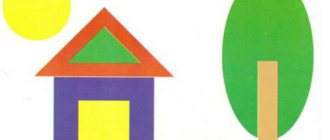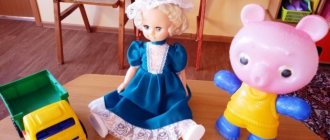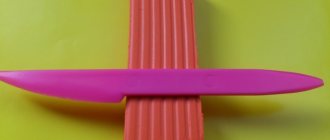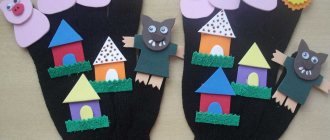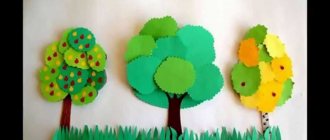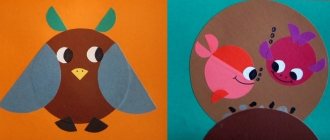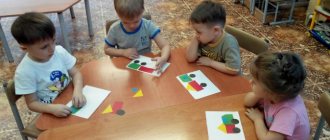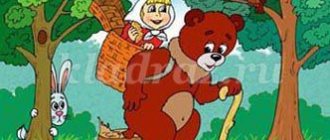Class in the middle group on fine arts - modeling “If you want to be healthy...”
Modeling lesson “If you want to be healthy...”
Educational objective:
Formation of the ability to experiment and create simple images from plasticine, the ability to independently convey images of objects using available visual means (in particular plasticine);
Teach children to sculpt sports equipment in a constructive way. To form children’s initial ideas about sports equipment.
Developmental task:
Develop shaping abilities using plasticine; To develop in children the ability to properly engage in sports and physical education;
Develop fine motor skills of the hands, eye, coordination in hand movements;
Educational task:
Cultivate children's interest in modeling sports equipment of their choice.
Materials and equipment: red, yellow and black plasticine, stacks, napkins, pictures for viewing on the theme “Health” and “Sports”, pre-made figures (weight, jump rope, dumbbells and hoop).
Progress of direct educational activities:
Children join the group to cheerful, rhythmic music. There are dumbbells for each child on the floor. While the children look at the dumbbells, the teacher reads a poem
My dad loves music.
I keep up with him.
He plays the harmonica
I'll lift the dumbbells.
Educator:
Guys, today a bear cub came to visit us, whose name is Tishka. Let's say hello to him. (Children greet the bear by the paw). He is still small and not very strong. And for him to become strong, what does he need to do? (Children answer: Do exercises, play sports, etc.)
Educator:
Tishka Bear, why are your hands so weak?
Bear: Because, guys, I don’t eat much porridge and don’t drink milk at all.
Educator:
Do you want to have weak hands too? (No) What should you and I do to be strong and eat well? (Do physical education). Look at the dumbbells lying here. They are heavy. What can we do with their help? (pump up strength). What color are they? (Yellow, red). Tishka, look at what children can do to become strong and resilient. (Physical minute to the music “Everyone around is trying to play sports”)
Bear: Children, tell me, what sports do you know? (Children answer)
Educator:
Guys, do you like physical education? (Yes). And with the help of what objects do we become strong and healthy? (Children answer - balls, hoops, jump ropes, dumbbells, gymnastic walls). What do you think it is? (Children express their opinions)
— Sports equipment is what helps us become strong, healthy and resilient. Let's remember once again what applies to sports equipment? (Children answer).
- Now let's look at it. Let's look at the weight. What is she like? (the heaviest). (Children look at a kettlebell, a hoop, dumbbells and a jump rope).
- Let's try to become a little stronger with the help of these items. (Children take turns coming up and trying to jump rope, spin a hoop, lift a weight and dumbbells).
— Guys, what will happen if Tishka bear uses dumbbells incorrectly? (Children answer)
-Well done! Absolutely right! If you handle these items incorrectly, you can get hurt or drop a weight or dumbbells on your own or a friend's leg. Therefore, such exercises should only be performed with adults!
“Children, let’s make a jump rope, a weight, dumbbells and a hoop for Tishka.”
— Girls, what sports equipment do you like best? (jump ropes and hoop).
- Boys! And you? (weights, dumbbells). (The teacher invites two girls to demonstrate how they jump rope and twirl a hoop, and for the boys to demonstrate how to lift a weight and dumbbells, Tishka the bear helps them)
- Well done!
- Now let's get to work. Girls will make jump ropes and hoops, and boys will make weights and dumbbells. (The teacher demonstrates how to sculpt dumbbells, a jump rope, a kettlebell, a hoop. Children choose the color of plasticine and begin to sculpt sports equipment).
- Girls, I prepared some threads for your rolling pins. You only need to make two cylinders for the handles.
(Children make the rest of the sports equipment as shown by the teacher).
- Well, children. You and I have worked hard today. What have we made? (Children's answers).
Bear: Oh, guys, I really liked it with you. I became much stronger and really wanted to eat porridge and drink milk. Well, that's it, I ran. Goodbye! See you again!
- Bye! Bye! (Children say goodbye to Tishka the bear).
Educator:
Today in class we learned what sports equipment is, how you can work with it, what it is needed for. Guys, why can’t you play with sports equipment? What will you tell your family and friends about health, about how to become strong and resilient. (Children's answers).
Summary of GCD on plasticineography in the middle group on the topic: Healthy lifestyle
Abstract of GCD on artistic and aesthetic development in the middle group on the topic “You need to know how to become healthy” with presentation
Topic. “You need to know how to become healthy.” Goal: To develop children's creative abilities through the use of an unconventional drawing technique - plasticineography. Objectives: - learn to convey the simplest image of objects through plasticineography; — teach the basic techniques of plasticineography (pinching, rolling, pressing)
;
— learn to work in a given space; - develop accuracy and fine motor skills; - cultivate independence, aesthetic feelings, interest in creative work. Modeling techniques: - pinching, pressing; - smearing with a finger over the entire drawing; - do not go beyond the outline of the object; - use a glass or napkin. Material: - plasticine of different colors; — transparent film with a printed outline of sports items according to the number of children; - board for plasticine; - stacks, napkins for hands, board - substrate for working with plasticine; - cold doll; — ribbed board (bridge)
;
— a screen for designing and analyzing work; — presentation in Pover Point; - musical fragments. Previous work: • reading fairy tales: L. Shchepacheva.
“How the little bear Shunya sought health,” Iris Review. Fairy tale “About smart health”; • solving riddles; • finger games: “Here are my helpers”, “We sculpted for a long, long time”; • physical education, “Give us some warmth, sunshine,” “Stretch”; • drawing of sports objects, modeling of sports objects; • sports games with a ball, hoop, skipping ropes, ribbons; • examination of illustrations of sports items and various sports. Progress of GCD
Organizational moment. The teacher organizes joint play activities in the sedentary game “Walk through - don’t hit”; "Pass the ball." Psychological mood. Slide No. 2 (March)
.
(Children in sportswear enter the group to the music)
.
Physical education lesson (Children follow the teacher one after another)
.
Educator: We start doing exercises in the morning, so that we less often turn to doctors for advice. (Form a circle, perform movements according to the text)
All the guys got up early, Marching like soldiers, Hands up, hands down, Rise up on your toes!
Get up one more time! Smile at everyone, my friend! They raised their palms up and said “Hello”! (They say hello)
.
Educator: - Guys, why are you doing exercises? (to be healthy, vigorous)
.
How do you feel after exercise? (cheerful, cheerful)
Let's keep our good mood for the whole day and share it with our friends.
(They go to the tables and sit on the chairs that have been pushed back) The main part. Slide 3. (Sound of a child sneezing) Educator: - Is someone sneezing? Maybe one of you is sick? (No)
I’ll look behind the screen, maybe someone is sneezing behind it
(I take out a doll wrapped in a scarf from behind the screen)
.
Children: - This is a cold doll. Educator: - Let's say hello to the Cold (we say hello) Children: - The Cold is sick again. Educator: - Children, did you treat your cold? How? (They gave tea with honey, lemon, put on mustard plasters, gave medicines...)
Medicines do not help colds.
How can we help her recover? You know? (She needs to do gymnastics, physical education, sports)
.
Right! That's why the Cold turned to you for help: it doesn't know what sports equipment is needed to play sports. Do you know sports items? (Yes)
Can you show them to her and tell her how they are played with?
(Yes)
Let's show her our sports album.
Slides from No. 5-No. 9.
1. Children play volleyball.
To play volleyball you need a volleyball. This ball is hit by hand. 2. A soccer ball is needed to play soccer. This ball is kicked. 3. Children can do gymnastics with dumbbells and a hoop. 4. For gymnastics, you can take a skipping rope. 5. You can perform gymnastics with gymnastic ribbons. Educator: - Oh, children, so many sports items! How will the Cold remember them all? Let's draw pictures of sports items for her and give them as gifts, and at home Cold will choose something from them for herself. (Agree)
Move the chairs to the table.
Sit closer. — Look and tell me, what material will you use to draw sports objects? (Plasticine)
That's right, but what you see is not ordinary plasticine, but magical one.
And you will draw with magic plasticine on magic transparent film! The outline of your future sports item has already been applied to the film; it needs to be painted over with plasticine using the smearing method. See what sports items you will paint with plasticine? (Stencils are laid out on the tables) (Children have chosen a sports object in advance, the outline of the sports object is drawn on the film. They look at the outline on the plastic square. Exchange impressions)
.
Educator: - Do you remember how to create a picture using the smearing method? (Child tells)
.
Christina, come, show me how you will “draw” with plasticine on a stencil between the contour lines? (He says: “I tear off a small piece of plasticine from a large one and begin to smear it on the stencil between the contour”)
.
Well done! - Why do you need a stack? (we will erase the plasticine with a stack if we go beyond the outline of the object)
.
— Why do you need a napkin? (at the end of the work, we will wipe off the excess plasticine from the film and dry our hands)
.
-Right. Well done. The cold is so eager to see pictures of sports items. — Before we begin, let's stretch our fingers to make it easier for them to work with plasticine. Stand on your feet near the table. Finger warm-up (standing at the table)
Here are my assistants
(pointing and looking at open palms)
, turn them the way you want.
And like this, and like this (turn their hands up, palms up, then down)
, They won’t be offended in any way
(rub their palms together)
.
One, two, three, four, five (bend their fingers, starting with the little finger)
They don’t sit well again
(clap their hands)
.
They knocked (with their fists on their knees)
, turned them
(twirled their fists)
and wanted to work
(rubbed their hands)
.
(Sit down)
- Take plasticine of any color you like.
(Choose)
.
Separate a small piece from it. Place plasticine between the contour lines and start smearing. Educator: (Children do the work independently. I help with advice, guiding questions, individual demonstration of modeling methods. I remind them of the time when they need to finish “drawing”)
.
- You guys are so great, it turns out so beautifully. Cold says she can't wait to see what sports items you drew for her. Whoever has already drawn, let's place them on the board so everyone can see. (Children bring it.)
Final part.
(Children stand with the teacher near the board)
.
Physical school While we were drawing (the actions in question are being carried out)
, our eyes are so tired.
We will let them rest, We will close them for a little while. Now let’s open them and blink a little. (Pay attention to the board with drawings)
.
Educator: - Oh, what bright pictures! Can you tell us who and what of you drew for Cold?! (list)
What beautiful balls, jump ropes...!
The cold says that she wanted to pick them up and play. Guys, can you play with these items in a group? (Outside, in the fresh air)
That's right.
Let's invite Cold to go for a walk, where she will play sports games with you. We will put your drawings in an album and give it to her. Let's remind the Cold why you need to exercise? (to always be healthy)
.
Reflection. Educator: - Guys, look at your hands after “drawing.” Do you see the remains of magic plasticine on them? Do you know how to remove plasticine from your hands? (You need to wash your hands)
And cleanliness is also a guarantee of health.
Wash your hands, I will lead you to the source of health. Get up one after another, we will go to the water through the stream along this bridge (ribbed board)
.
(Children go to wash their hands after the teacher)
.
Presentation on the topic: You need to know how to become healthy
We recommend watching:
Notes for a lesson in the middle group on the works of Marshak Notes for a lesson in kindergarten on cognitive development with children in the middle group “Journey of the Foxes” Notes for a lesson on cognitive development in the middle group “In Search of Treasures” Notes for a lesson in the middle group. History of the book
Similar articles:
Summary of a lesson in kindergarten in the middle group “What I love”
Math lesson “Rectangle” in the middle group of kindergarten
Summary of GCD for modeling
Summary of GCD in the middle group “Journey to the land of health” Modeling + Cognition (integration of OO) Summary of GCD in the middle group “Journey to the land of health” Modeling + Cognition (integration of OO)
Summary of GCD in the middle group
“Journey to the Land of Health” Modeling + Cognition (OO integration)
Educational areas: artistic creativity (sculpting, safety, cognition
Tasks:
— To develop children’s ability to properly care for their teeth, to explain to children why it is necessary to take care of their teeth from childhood;
— Clarify children’s ideas about healthy and proper nutrition, give ideas that foods can be healthy and harmful for teeth;
— Strengthen children’s ability to sculpt round and elongated objects.
— Cultivate a desire to take care of your health.
— Develop children’s speech, attention, thinking.
Equipment.
Toothbrush, paste, illustrations of teeth (“cheerful” and “sad”, pictures “Harm to teeth”, pictures of vegetables and fruits, plasticine for each child, modeling boards, napkins, small pictures of a cheerful and sad tooth (by number children, 2 toy plates.
Progress of the lesson.
Org. moment. Children sit on chairs in a semicircle.
Q. Guys, we have guests today. Let's say hello to them! (children say hello). I suggest you get ready for work. Repeat with me.
Hello, golden sun! (reached up)
Hello, blue sky! (hands spread)
Hello, free breeze! (shaked hands)
Hello little sprout! (crouched down, hands down to the ground)
Hello, my dear friend! (extend hands to neighbor).
Motivational stage. Updating knowledge.
Q. Guys, do you like to travel? Have you ever been to the land of health? Today we will go to the land of health. You are ready? Get on the train. Let's hit the road! The Blue Carriage music plays, children move around the group to the music. The teacher of the first trailer is the helmsman. “Choo-choo! » They approach the table, on which there is a toothbrush and toothpaste under a cape.
V. This is the first stop. There's something here, let's see. What is this? Points to the toothbrush. Why is it needed? And what's that? Shows toothpaste. Do you know how to brush your teeth? Let's brush our teeth.
Articulation gymnastics “Brushing your teeth” (picture)
Kitty Muzik got up in the morning and smiled
I ran to brush my teeth. open your mouth
Right-left, right-left, “clean” with the tip of your tongue from the inside
We brush our teeth skillfully. alternately lower and upper teeth 5-6 times
Let's rinse your mouth
Like a neat cat. "rinse your mouth"
Q. What great guys you all are, you know how to brush your teeth. Now let's move on.
To the music, the children move further in the group to the chairs.
Q. Here's the next stop. Sit down on the chairs.
Illustrations of “happy” and “sad” teeth are displayed on the easel.
B. Look at the illustration. What is this? Why is he smiling? Yes, he is cheerful because he is healthy. The teacher shows an illustration of a sad tooth.
Q. What happened to this tooth? Why is he so sad? Why can a tooth get sick? The pictures will help you. (children take turns speaking, chewing nuts with their teeth, picking their teeth, eating sweets, not going to the doctor, not brushing their teeth)
Guys, not every food is good for our teeth. Now we will play with you.
Game “What is useful and what is harmful”
I will tell you the words - food. If it is good for your teeth, clap your hands; if it is harmful, stomp your feet. (carrots, beets, cabbage, cucumber, tomato, apple, pear, chips, candies, chocolates, hot tea, ice cream, milk, cheese)
Outdoor game "In an even circle"
Rules of the game:
Children stand in a circle. In the middle of the circle is a child playing the role of soap. Children walk one after another in a circle, singing a song:
In an even circle, one after another, We will walk merrily, Whatever the soap shows us here, That’s what we will do.
Soap shows how to soap your hands, the children repeat the movements. Then the corresponding movement shows a towel (comb, toothbrush, washcloth, handkerchief).
Practical stage.
Q: Guys, let's blind it, and guess what.
The tail is made of bone and there are bristles on the back.
(Children sculpt while standing at the tables; calm music sounds while sculpting).
First, let's prepare the fingers.
Finger gymnastics
Self-massage:
“My, my chimney sweep - rubbing the palms Clean, clean, clean, clean! - stroking the face Will, will, chimney sweep - circular stroking of the belly Clean, clean, clean, clean!” - tapping feet with fists.
Our fingers are ready. Choose what you will sculpt, select the color of the plasticine. The pictures on the board are helpers. Don't forget to warm up the plasticine. (independent work, musical accompaniment). Dry your hands with tissues.
Bottom line. Reflection.
Place your fruits and vegetables on plates.
We'll show them to our parents and our guests will watch them. And you and I will go to the mat. Those who liked the lesson, those who learned a lot, choose a happy tooth, those who were not interested and didn’t learn anything, choose a sad tooth. And it was interesting for me to work with you, you worked hard today, I’ll choose a funny tooth. Thanks for the work! Author: Zharkova Ella Yurievna
Modeling vegetables and fruits healthy products middle group
Summary of a modeling lesson in the middle group “Make whatever fruits or vegetables you want”
Topic: “Make whatever vegetables or fruits you want”
Goal: To develop children’s ability to choose the content of their work from a range of specific subjects.
Objectives: To foster independence and activity. Strengthen the ability to convey the shape of vegetables and fruits using a variety of sculpting techniques. Develop imagination.
Facilities:
Plasticine, modeling board, object pictures depicting vegetables and fruits, a tray with fruits and vegetables.
Methods:
Game situation, literary expression, showing how to do the work, instructions, help.
Progress of the lesson
There's a knock on the door. They pass a tray covered with a tablecloth and a letter to the door and ask if this is the group “Solnyshko”. The teacher accepts the parcel and addresses the children:
- Guys, oh, what is this? (Reads the letter) Look, Autumn sent us this. Here are the gifts of her harvest.
-Let's see what we have here. (We look at each vegetable and fruit and give a brief description, in Russian and Kalmyk).
-Guys, today we will sculpt vegetables and fruits from plasticine, and you will choose what exactly you will sculpt according to your desire.
-Let's remember how we sculpt round and oblong objects (I show in the air). We must take a whole piece of plasticine and begin to roll it in a circular motion. We are the ones who sculpt round objects. Show us how we'll ride. That's right, well done!
